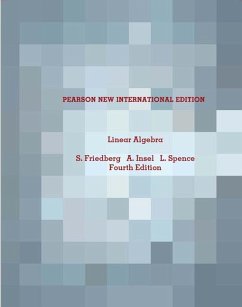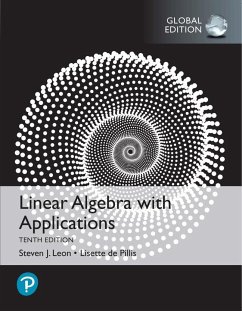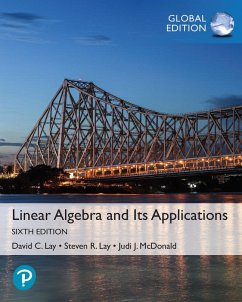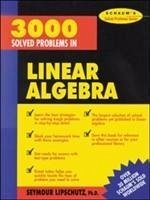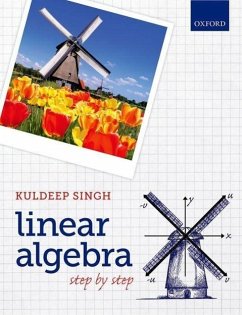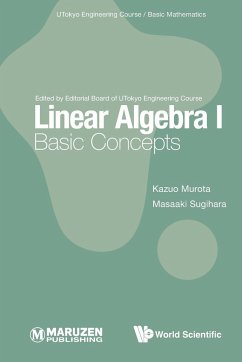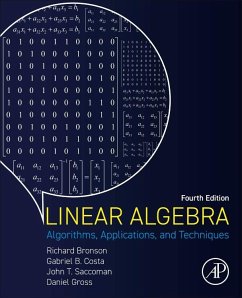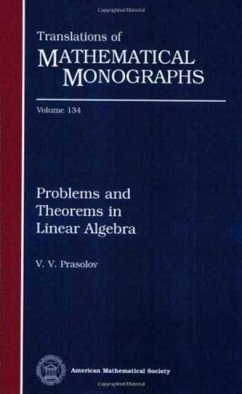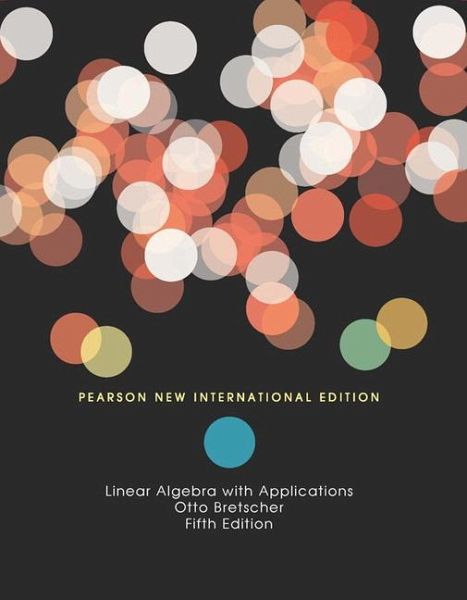
Linear Algebra with Applications
Pearson New International Edition
Versandkostenfrei!
Versandfertig in 2-4 Wochen
111,99 €
inkl. MwSt.

PAYBACK Punkte
56 °P sammeln!
Offering the most geometric presentation available, Linear Algebra with Applications, Fifth Edition emphasizes linear transformations as a unifying theme. This elegant textbook combines a user-friendly presentation with straightforward, lucid language to clarify and organize the techniques and applications of linear algebra. Exercises and examples make up the heart of the text, with abstract exposition kept to a minimum. Exercise sets are broad and varied and reflect the author’s creativity and passion for this course. This revision reflects careful review and appropriate edits throughout, while preserving the order of topics of the previous edition.
Features + Benefits
Linear transformations are introduced early in the text to make the discussion of matrix operations more meaningful and easier to navigate.
Visualization and geometrical interpretation are emphasized extensively throughout the text.
An abundance of problems, exercises, and applications help students assess their understanding and master the material.
Abstract concepts are introduced gradually throughout the text. Major ideas are carefully developed at various levels of generality before the student is introduced to abstract vector spaces.
Discrete and continuous dynamical systems are used as a motivation for eigenvectors and as a unifying theme thereafter.
Fifty to sixty True/False questions conclude every chapter, testing conceptual understanding and encouraging students to read the text.
Historical problems from ancient Chinese, Indian, Arabic, and early European sources add diversity to the selection of exercises.
Rotations, reflections, projections, and shears are used throughout to illustrate new ideas.
Multiple perspectives on the kernel of a matrix are presented, with a stronger emphasis on the relations among the columns.
Commutative diagrams enhance students' conceptual understanding of the matrix of a linear transformation. These diagrams enable students to visualize the relations between linear transformations.
A more conceptual approach to the QR factorization is presented, in terms of a change-of-basis.
1. Linear Equations
1.1 Introduction to Linear Systems
1.2 Matrices, Vectors, and Gauss-Jordan Elimination
1.3 On the Solutions of Linear Systems; Matrix Algebra
2. Linear Transformations
2.1 Introduction to Linear Transformations and Their Inverses
2.2 Linear Transformations in Geometry
2.3 Matrix Products
2.4 The Inverse of a Linear Transformation
3. Subspaces of Rn and Their Dimensions
3.1 Image and Kernel of a Linear Transformation
3.2 Subspace of Rn; Bases and Linear Independence
3.3 The Dimension of a Subspace of Rn
3.4 Coordinates
4. Linear Spaces
4.1 Introduction to Linear Spaces
4.2 Linear Transformations and Isomorphisms
4.3 The Matrix of a Linear Transformation
5. Orthogonality and Least Squares
5.1 Orthogonal Projections and Orthonormal Bases
5.2 Gram-Schmidt Process and QR Factorization
5.3 Orthogonal Transformations and Orthogonal Matrices
5.4 Least Squares and Data Fitting
5.5 Inner Product Spaces
6. Determinants
6.1 Introduction to Determinants
6.2 Properties of the Determinant
6.3 Geometrical Interpretations of the Determinant; Cramer's Rule
7. Eigenvalues and Eigenvectors
7.1 Diagonalization
7.2 Finding the Eigenvalues of a Matrix
7.3 Finding the Eigenvectors of a Matrix
7.4 More on Dynamical Systems
7.5 Complex Eigenvalues
7.6 Stability
8. Symmetric Matrices and Quadratic Forms
8.1 Symmetric Matrices
8.2 Quadratic Forms
8.3 Singular Values
Appendix A. Vectors
Appendix B: Techniques of Proof
Answers to Odd-numbered Exercises
Subject Index
Name Index
Features + Benefits
Linear transformations are introduced early in the text to make the discussion of matrix operations more meaningful and easier to navigate.
Visualization and geometrical interpretation are emphasized extensively throughout the text.
An abundance of problems, exercises, and applications help students assess their understanding and master the material.
Abstract concepts are introduced gradually throughout the text. Major ideas are carefully developed at various levels of generality before the student is introduced to abstract vector spaces.
Discrete and continuous dynamical systems are used as a motivation for eigenvectors and as a unifying theme thereafter.
Fifty to sixty True/False questions conclude every chapter, testing conceptual understanding and encouraging students to read the text.
Historical problems from ancient Chinese, Indian, Arabic, and early European sources add diversity to the selection of exercises.
Rotations, reflections, projections, and shears are used throughout to illustrate new ideas.
Multiple perspectives on the kernel of a matrix are presented, with a stronger emphasis on the relations among the columns.
Commutative diagrams enhance students' conceptual understanding of the matrix of a linear transformation. These diagrams enable students to visualize the relations between linear transformations.
A more conceptual approach to the QR factorization is presented, in terms of a change-of-basis.
1. Linear Equations
1.1 Introduction to Linear Systems
1.2 Matrices, Vectors, and Gauss-Jordan Elimination
1.3 On the Solutions of Linear Systems; Matrix Algebra
2. Linear Transformations
2.1 Introduction to Linear Transformations and Their Inverses
2.2 Linear Transformations in Geometry
2.3 Matrix Products
2.4 The Inverse of a Linear Transformation
3. Subspaces of Rn and Their Dimensions
3.1 Image and Kernel of a Linear Transformation
3.2 Subspace of Rn; Bases and Linear Independence
3.3 The Dimension of a Subspace of Rn
3.4 Coordinates
4. Linear Spaces
4.1 Introduction to Linear Spaces
4.2 Linear Transformations and Isomorphisms
4.3 The Matrix of a Linear Transformation
5. Orthogonality and Least Squares
5.1 Orthogonal Projections and Orthonormal Bases
5.2 Gram-Schmidt Process and QR Factorization
5.3 Orthogonal Transformations and Orthogonal Matrices
5.4 Least Squares and Data Fitting
5.5 Inner Product Spaces
6. Determinants
6.1 Introduction to Determinants
6.2 Properties of the Determinant
6.3 Geometrical Interpretations of the Determinant; Cramer's Rule
7. Eigenvalues and Eigenvectors
7.1 Diagonalization
7.2 Finding the Eigenvalues of a Matrix
7.3 Finding the Eigenvectors of a Matrix
7.4 More on Dynamical Systems
7.5 Complex Eigenvalues
7.6 Stability
8. Symmetric Matrices and Quadratic Forms
8.1 Symmetric Matrices
8.2 Quadratic Forms
8.3 Singular Values
Appendix A. Vectors
Appendix B: Techniques of Proof
Answers to Odd-numbered Exercises
Subject Index
Name Index
Offering the most geometric presentation available, Linear Algebra with Applications, Fifth Edition emphasizes linear transformations as a unifying theme. This elegant textbook combines a user-friendly presentation with straightforward, lucid language to clarify and organize the techniques and applications of linear algebra. Exercises and examples make up the heart of the text, with abstract exposition kept to a minimum. Exercise sets are broad and varied and reflect the author's creativity and passion for this course. This revision reflects careful review and appropriate edits throughout, while preserving the order of topics of the previous edition.
Dieser Artikel kann nur an eine deutsche Lieferadresse ausgeliefert werden.



